DownNDirty
Bronze Member
- Joined
- Jun 1, 2015
- Messages
- 2,178
- Reaction score
- 3,207
- Golden Thread
- 1
- Location
- South Carolina
- 🥇 Banner finds
- 1
- 🏆 Honorable Mentions:
- 1
- Detector(s) used
- Minelab Equinox 800
- Primary Interest:
- All Treasure Hunting
Last Friday afternoon I spent about three hours exploring a 900+ permission that I gained last spring, and the time was well spent. I had my eye on a wooded ridge because it looked like a likely location for a home site. Just before I ascended the ridge I came across a creek that does not appear on any map, which raised the chances that a house had been on the ridge.
I found this brass relic not far from the creek; it looks like the top part of a salt/pepper shaker.
It has a lid with holes that line up with the main part; very odd.
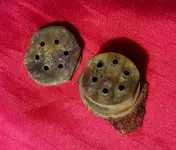
UPDATE: DCMatt pm'd me with the following information:
"Your 'salt shaker' top may well be from a 'ponce pot' (often spelled pounce). Ponce was a sand-like substance (actually gum sandarac) used to help absorb and dry ink on newly written letters and documents. It was applied using a small jar that looks muck like a salt shaker."
Thanks Matt!
As I got close to the ridge crest the iron signals got heavier. Then I picked up a good signal, dug it and out popped this 18th century paste (faceted glass) knee buckle
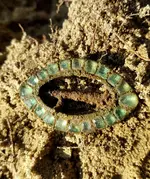
Part of the iron chape is still there but some of it has rusted away. This is by far best knee buckle I have found yet; thanks Bill D for the id
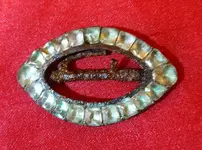
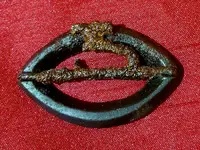
So basically I had found a virgin 18th century home site. In the South they are very hard to locate because most homes of the colonial era were made of wood without stone cellars or stone walls like those of the Northeast. But in most cases when you do locate one it has never been detected, and based on the extent of my finds this is one of those.
For the rest of the day Friday I concentrated on this site and located the spot where the house had been. Then I returned Saturday and Sunday and continued to find good numbers of 18th century relics; I'll combine the finds here without a daily "play-by-play."
The site produced a number of buckles including these two small, completely intact ones; not sure how they were used but obviously they were used with clothing. The larger one has almost all of the gilt on it and the other one has traces of silver plating
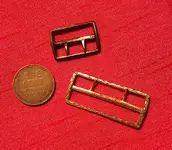
I also found three intact horse buckles and two thin iron buckles of a type I have never seen. Any thoughts as to their use?
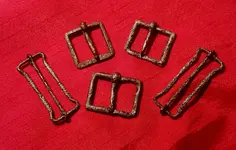
Lastly I dug this cool shield-shaped harness buckle on a "walkabout" around the site perimeter
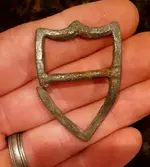
Here s a brass horse harness ornament from the site
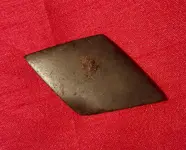
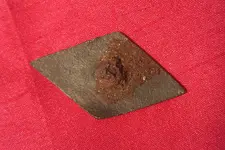
One of the more interesting relics I found was a nearly complete musket frizzen; I believe it's from a Brown Bess but I'm not positive
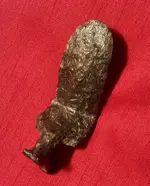
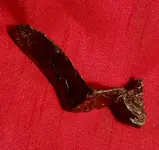
Two early 1700s pewter spoon handles told me that this was a very early home site. The "dog-nosed" handle has a hallmark/makers mark-if anyone has info on it please post a comment
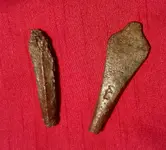
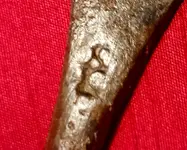
Speaking of pewter I did dig this pewter button that has a design on the front
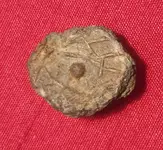
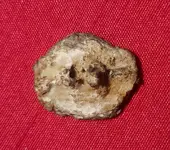
All in all I dug 14 flat buttons over the weekend-some with fancy engraving
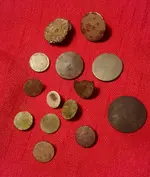
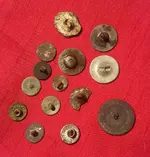
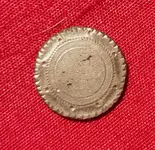
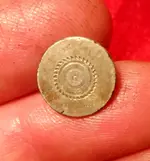
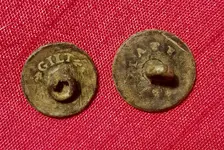
The other non-ferrous relic that I dug was a really nice small thimble
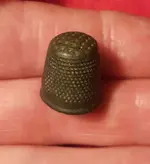
And here are the iron targets that came home with me (other than those that went to the trash can). The best was a large axe that was 12 inches deep and is heavily encrusted
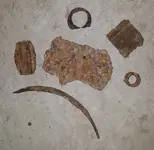
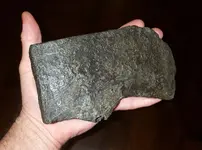
All in all it was a really fun weekend at a new site. I can't wait to sift the dirt there because I know that there is a lot left that is being masked by nails. Sorry for the long post and thanks for reading it all.
I found this brass relic not far from the creek; it looks like the top part of a salt/pepper shaker.
It has a lid with holes that line up with the main part; very odd.

UPDATE: DCMatt pm'd me with the following information:
"Your 'salt shaker' top may well be from a 'ponce pot' (often spelled pounce). Ponce was a sand-like substance (actually gum sandarac) used to help absorb and dry ink on newly written letters and documents. It was applied using a small jar that looks muck like a salt shaker."
Thanks Matt!
As I got close to the ridge crest the iron signals got heavier. Then I picked up a good signal, dug it and out popped this 18th century paste (faceted glass) knee buckle

Part of the iron chape is still there but some of it has rusted away. This is by far best knee buckle I have found yet; thanks Bill D for the id


So basically I had found a virgin 18th century home site. In the South they are very hard to locate because most homes of the colonial era were made of wood without stone cellars or stone walls like those of the Northeast. But in most cases when you do locate one it has never been detected, and based on the extent of my finds this is one of those.
For the rest of the day Friday I concentrated on this site and located the spot where the house had been. Then I returned Saturday and Sunday and continued to find good numbers of 18th century relics; I'll combine the finds here without a daily "play-by-play."
The site produced a number of buckles including these two small, completely intact ones; not sure how they were used but obviously they were used with clothing. The larger one has almost all of the gilt on it and the other one has traces of silver plating

I also found three intact horse buckles and two thin iron buckles of a type I have never seen. Any thoughts as to their use?

Lastly I dug this cool shield-shaped harness buckle on a "walkabout" around the site perimeter

Here s a brass horse harness ornament from the site


One of the more interesting relics I found was a nearly complete musket frizzen; I believe it's from a Brown Bess but I'm not positive


Two early 1700s pewter spoon handles told me that this was a very early home site. The "dog-nosed" handle has a hallmark/makers mark-if anyone has info on it please post a comment


Speaking of pewter I did dig this pewter button that has a design on the front


All in all I dug 14 flat buttons over the weekend-some with fancy engraving





The other non-ferrous relic that I dug was a really nice small thimble

And here are the iron targets that came home with me (other than those that went to the trash can). The best was a large axe that was 12 inches deep and is heavily encrusted


All in all it was a really fun weekend at a new site. I can't wait to sift the dirt there because I know that there is a lot left that is being masked by nails. Sorry for the long post and thanks for reading it all.
Last edited:
Upvote
37



 -not likely).
-not likely).